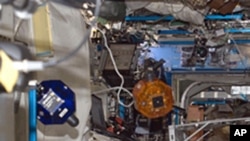Astronauts achieved the primary goal of the space shuttle Endeavour's final mission Thursday when they installed an instrument called the Alpha Magnetic Spectrometer on the International Space Station. Scientists have lofty aims for this $2 billion device that will comb through particles in the cosmos. These aims that can best be understood if we look at our own world.
To most people, so-called "normal matter" is really all that matters. Normal matter is anything with atoms - basically, our world. Everything from the person next to you to the car you drive to the fuel in its tank, from the air you breathe to the water you drink to the clothes on your back.
But astronomers estimate that only a fraction of our universe - maybe less than five percent - is made of so-called "normal matter." They say the rest of our universe is made up of mysterious dark energy and dark matter. By their very nature, dark energy and dark matter are not visible, but they can still be detected.
In order to shed some proverbial light on dark energy and dark matter, hundreds of scientists from 16 countries worked to create the Alpha Magnetic Spectrometer, or AMS.
Scientists hope this sophisticated instrument will yield insights into the composition and origins of our universe.
Earlier this week, NASA flight director Gary Horlacher told reporters that this new instrument and the discoveries it is expected to make reminded him of another marvel - the Hubble Space Telescope, which has delivered spectacular images of the universe from its orbit 570 kilometers above the Earth.
"You set up these scientific experiments to go off and look for a certain collection of things you're trying to prove or discover, and you end up learning something that you didn't expect which, you know, the Hubble [Space Telescope] has done that," said Horlacher. "All the great observatories have ended up surprising us. So, not only do we expect great things from AMS, but there is also a high probability we are going to learn quite a bit that we didn't even expect."
The AMS is a sophisticated particle detector that will use a large magnet to create a magnetic field that will bend the path of charged cosmic particles that are traveling through space. It will not capture the particles, but various instruments will automatically provide information about the particles to scientists in 16 countries.
The $2 billion instrument will be operated remotely from Earth. The AMS team will monitor the experiment 24 hours a day for as long as the space station is in orbit.









